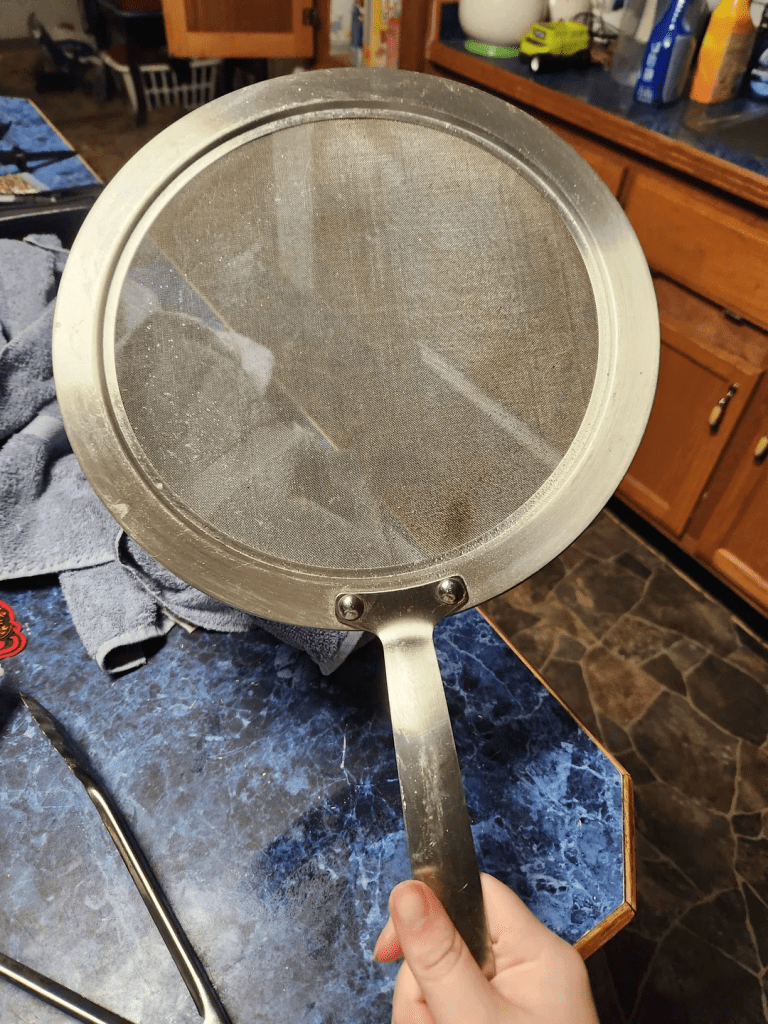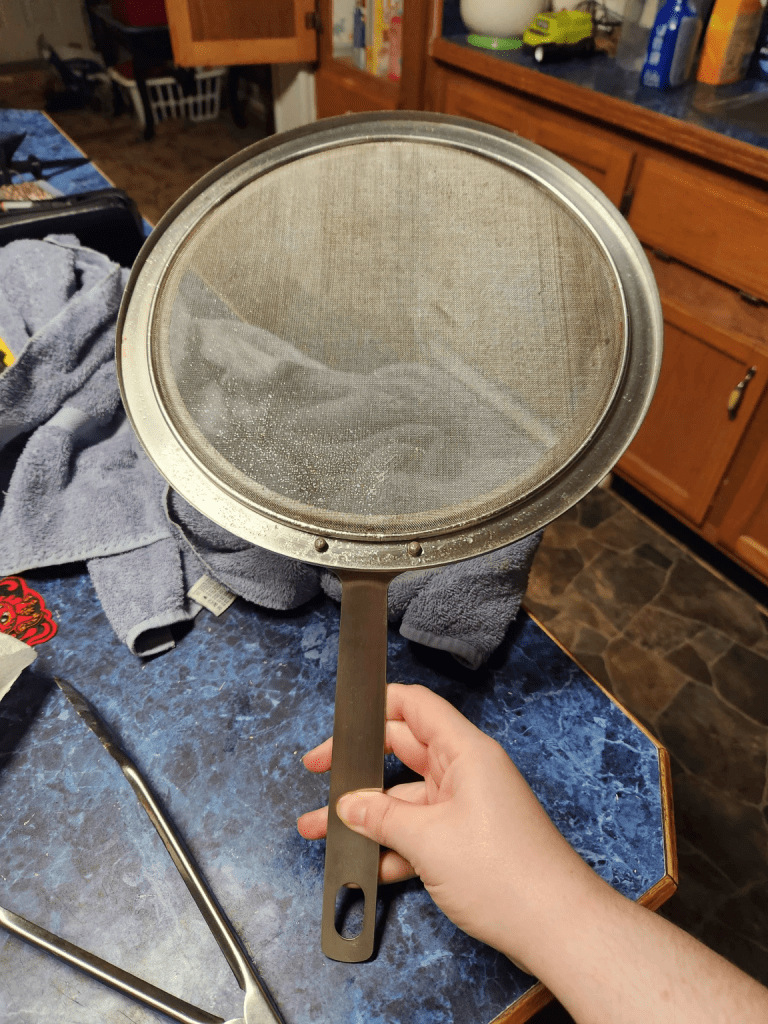The splatter screen might seem like a simple kitchen tool, but it holds an essential place in the evolution of culinary safety and efficiency. As anyone who has experienced the sting of hot oil knows, frying can be a messy and risky endeavor. This unassuming mesh cover, designed to shield against oil splatters, has a fascinating history and continues to be a vital asset in modern kitchens. Let’s dive into the legacy, usage, and timeless relevance of the splatter screen.

A Glimpse into the History of the Splatter Screen
The origins of the splatter screen can be traced back to the early 20th century, a time when home cooking was gaining popularity. As frying and sautéing became more commonplace, so did the need for tools that could make these cooking methods safer and cleaner. Enter the splatter screen—a practical innovation that offered a solution to the problem of hot oil splattering during cooking.
Originally crafted from fine mesh or metal wire, early splatter screens provided a barrier that allowed steam to escape while blocking oil droplets from reaching the stovetop or unsuspecting hands. This not only prevented painful burns but also helped maintain a cleaner kitchen. Over time, the design and materials used in splatter screens evolved to cater to the changing needs of cooks, making them more efficient and versatile.
How the Splatter Screen Became a Staple in Kitchens
The splatter screen was an instant hit in kitchens because it addressed a common problem in an affordable and simple way. As home cooking became more sophisticated, so did the need for tools that offered safety and convenience. By keeping oil contained, the splatter screen helped cooks fry food without the worry of greasy messes and painful burns, making it a valuable asset in the kitchen.
Through the years, the splatter screen became available in different materials like stainless steel, silicone, and even hybrid models combining both. This evolution in materials helped the tool withstand higher temperatures and made it easier to clean. As a result, it remains a staple in kitchens today, thanks to its continued effectiveness and adaptability to various cooking methods.
Using a Splatter Screen in the Kitchen: Function and Versatility
At its core, the splatter screen serves a straightforward purpose: it acts as a shield over frying pans and pots to catch oil splatters. But beyond that primary function, it offers a range of benefits that make it incredibly versatile. Let’s explore how this tool is used and the various ways it enhances cooking.
1. Protecting Against Oil Splashes
The most obvious use of a splatter screen is to shield against splattering oil, especially during frying. Whether you’re making crispy bacon, sautéing vegetables, or frying up a batch of chicken, placing a splatter screen over the pan helps keep oil droplets contained. This means fewer burns on your hands and less oil on your stovetop and walls.
2. Allowing Steam to Escape

Unlike traditional lids, which trap moisture, splatter screens allow steam to escape. This is ideal for frying since it prevents food from becoming soggy. By letting moisture out, the splatter screen helps maintain the crispiness of fried foods and ensures an even cooking process. It’s perfect for recipes that require moisture control, like pan-seared meats or caramelized onions.
3. Making Cleanup Easier
One of the splatter screen’s best features is how it simplifies cleanup. By keeping oil and grease contained, it reduces the amount of mess on your stove, backsplash, and countertops. After cooking, a quick rinse or wipe down of the splatter screen is often all that’s needed, saving you time and effort in cleaning up after a meal.
4. Versatile Applications Beyond Frying
While primarily used for frying, splatter screens have other practical applications in the kitchen. You can place a screen over a pot of simmering sauce to prevent splatters or use it to cover a pan of boiling pasta that might otherwise bubble over. In some cases, people even use splatter screens as strainers for food or to keep insects out of cooling dishes when cooking outdoors.

The Evolution of Splatter Screens: Modern Designs and Features
Today’s splatter screens come in a variety of sizes, materials, and designs to suit different cooking needs. This tool has come a long way from its early days as a simple mesh cover, with many modern enhancements that improve its functionality and ease of use.
1. Heat-Resistant Silicone Edges
Some splatter screens feature silicone edges that allow them to sit securely on pans of various sizes. The heat-resistant silicone prevents the screen from sliding around, making it easier to cook without worrying about accidental shifts or spills. This added stability is particularly useful for high-heat frying, as it provides a reliable barrier between you and hot oil.
2. Folding and Collapsible Designs
For kitchens with limited storage space, folding and collapsible splatter screens offer a convenient solution. These screens fold down for easy storage in drawers or cabinets and expand when needed. They’re ideal for small kitchens or anyone looking to maximize their storage space.
3. Built-In Handles for Ease of Use
Many splatter screens come with built-in handles that make it easy to place and remove them from hot pans. These handles often feature heat-resistant materials, so you can safely lift the screen without using a pot holder. This makes the cooking process smoother and reduces the risk of burns when handling the screen.
The Lasting Legacy of the Splatter Screen

The splatter screen has earned its place in culinary history by providing a simple, effective solution to a common kitchen problem. Its legacy is a testament to the importance of practical tools that make cooking safer and cleaner. Even as cooking methods and kitchen technology continue to evolve, the splatter screen remains a relevant and indispensable tool, beloved by both home cooks and professional chefs alike.
Its continued popularity reflects a balance between traditional cooking techniques and modern convenience. By prioritizing safety, ease of use, and cleanliness, the splatter screen is a perfect example of how simple innovations can have a lasting impact on everyday life.
Why Every Kitchen Should Have a Splatter Screen
If you don’t already have a splatter screen in your kitchen, it’s time to consider adding one to your collection. With its versatility and practicality, a splatter screen offers a range of benefits that make it a worthwhile investment for any home cook. From frying bacon to simmering sauces, this tool is a small but mighty addition to your kitchen arsenal, making cooking safer and more enjoyable.
Conclusion: The Timeless Value of the Splatter Screen
The splatter screen may seem like a modest kitchen tool, but its impact is undeniable. By reducing mess and minimizing the risk of burns, it makes cooking more accessible and enjoyable. Whether you’re a seasoned chef or an occasional home cook, a splatter screen can be an invaluable tool, helping you create delicious dishes while keeping your kitchen clean and safe. So next time you’re frying up a storm, reach for your splatter screen and experience the benefits of this essential kitchen accessory.


